Tokyo 2020 Olympics track bikes guide: who's riding what and how much do they cost?
Everything you need to know about the top track bikes you'll see at the Izu velodrome
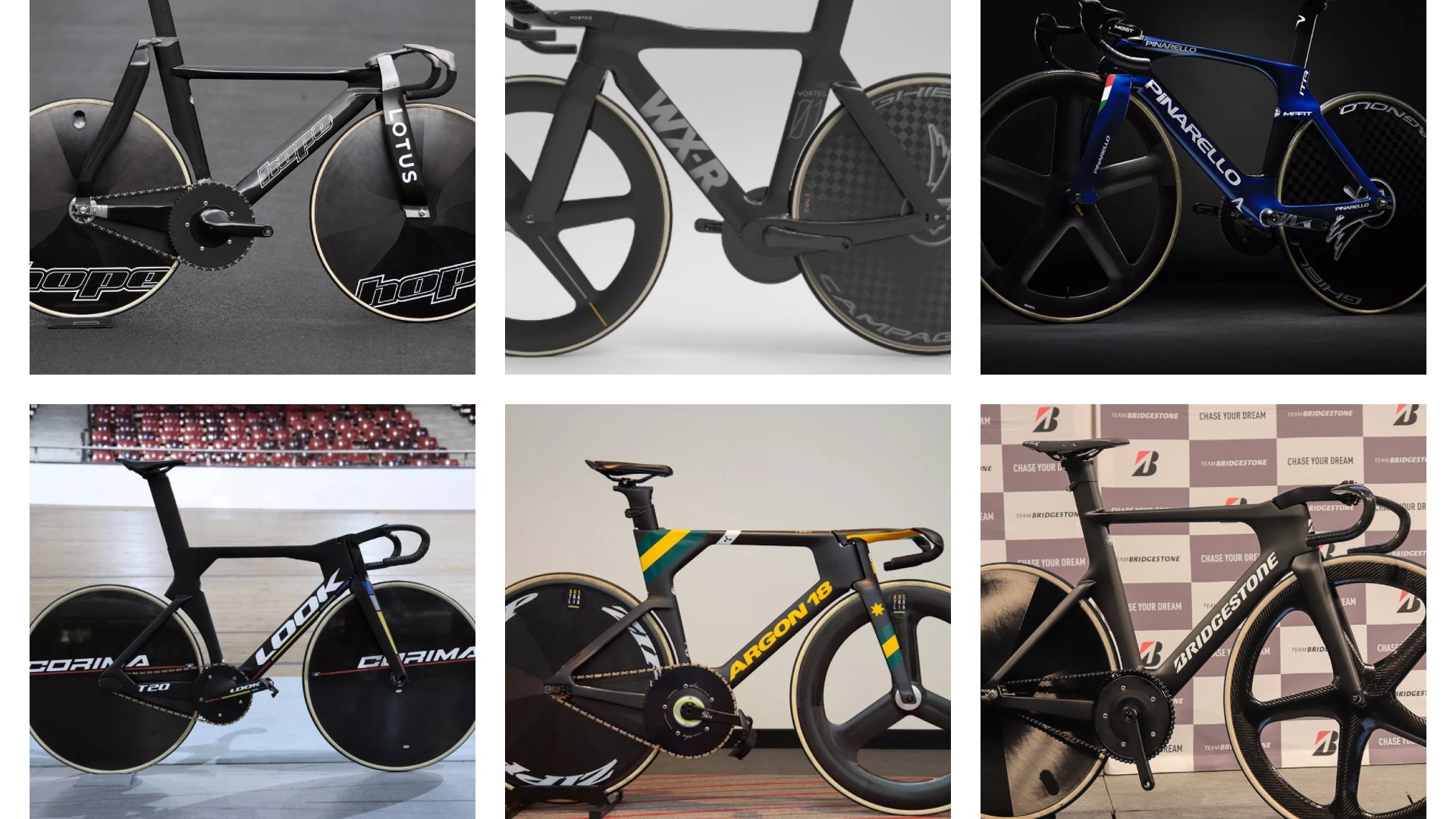

The cycling arms race in the four years building up to the Olympics often looks neck-and-neck with no nation ready to reveal their secret weapon until they can be absolutely sure it can't be stolen and copied.
In 1992 Team GB launched the revolutionary Lotus 108 at a low-key meet at Leicester in May, hoping it wouldn't attract too much attention. Other nations were unaware of its full potential until Chris Boardman broke the Olympic pursuit record on it in qualifying.
The latest Team GB Lotus bike was launched with considerably more fanfare at a strategic point in late 2019 - before main rivals Australia had launched theirs. However, little did we know that we would have to wait another whole year for the Tokyo Olympics. Considering the original Lotus was developed in little over seven months, it's fascinating to wonder what might have happened if another national federation had decided to copy the design once the Olympics were officially postponed.
Without a doubt the Hope x Lotus HB.T is the most radical machine to circle the Izu velodrome. Below we take a look at it, and at the other track bikes it's up against.
The nations with the larger Olympic cycling budgets will usually develop one bike for the sprint and bunch racing events and one for the team pursuit. Read more about the Olympic cycling disciplines in our guide to track cycling events.
Great Britain's Team GB track bike: Hope x Lotus HB.T

Hands down the most radical at the Olympics, Team GB’s track bike was designed by Hope Technology and Lotus Engineering along with input from British engineering company Renishaw.
British Cycling described it when it launched in October 2019 as "cutting edge" and said the bike had undergone extensive testing and production around the UK to make it as lightweight and aerodynamic as possible.
Get The Leadout Newsletter
The latest race content, interviews, features, reviews and expert buying guides, direct to your inbox!
The collaboration with Lotus is also a nod to Chris Boardman's 1992 Barcelona Olympics bike, the Lotus Type 108, which he rode to gold medal victory.
Around 40 people were involved in the development of the machine, including several veterans who made up the design team for the UK Sport Institute (UKSI) bike raced to victory time and time again in 2004, 2008 and 2012.
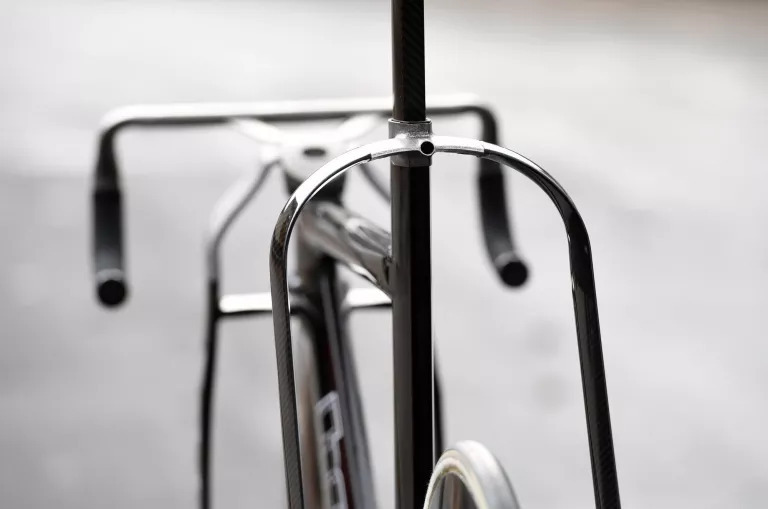
Most strikingly, the bike features 8cm wide forks and seatstays - with the goal of channelling air more efficiently around the rider’s legs.
BC’s technical director since 2013, Tony Purnell says the initial concept came from a search for space for creativity within the UCI rulebook.
“We knew we had to create something really special. But the rules were pretty restrictive! There was almost nothing we could do. We realised the only scope [for creativity] was that there were no real width restrictions.”
There are several factors involved in the aerodynamic difference between this bike and another – for example, since the seatstays are designed to mirror the rider’s legs, this machine will be more effective for some than others. However, estimations suggest it’s around 2-3% faster than previous track racing bikes.
Aside from the forks and bars coming from Lotus, precision manufacturing company Renishaw was an essential component to the bike’s development, with some of the more complex parts - such as the joint where the seat tube meets the seatstays - made possible with its 3D printing expertise.
The cost of the HB.T frame will be £7,500, but with both versions of the fork - for pursuit and sprint - clearing £4,000 it will be a ‘considered purchase’ for most people.
Australia: Argon 18 Electron Pro
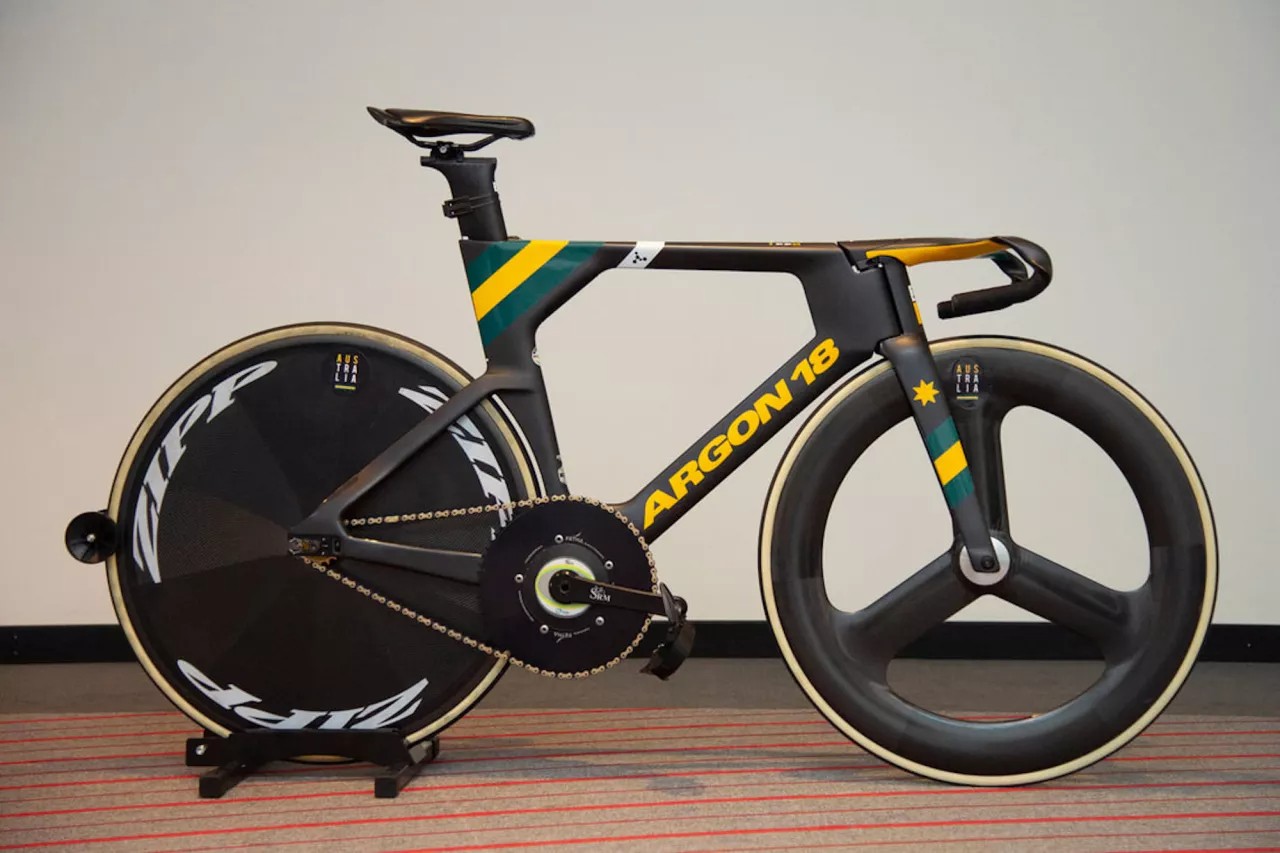
The Australian team finally unveiled their new Argon 18 track bikes for the Tokyo Olympics in February 2020.
After the British squad revealed the revolutionary Hope x Lotus bike in October 2019, their major rivals Australia left the world hanging for a few months before releasing photos of their striking-looking Argon 18 machines, complete with Zipp components.
The Electron Pro bikes were designed as part of a joint project between Argon 18, Cycling Australia, Zipp, Monash University and the University of Adelaide, with all the latest aero optimisation claimed for them.
VP of product at the Canadian bike builder Argon, Martin Flaubert, said: “This project brought together a team committed to innovation, optimisation, and performance.
“By combining resources to develop the best possible equipment, we now have a bike that pushes the boundaries in every way, giving riders every possible advantage in the quest for gold.”
Stand-out features for these bikes include the new slender pursuit fork and the custom-designed Zipp Super-9 Tubular Track Disc Aus wheelset, the custom-moulded sprint bars and pursuit extensions, and an integrated timing chip.
According to Cycling Australia, the bike took over 4,500 hours of engineering for the design, modelling and testing.
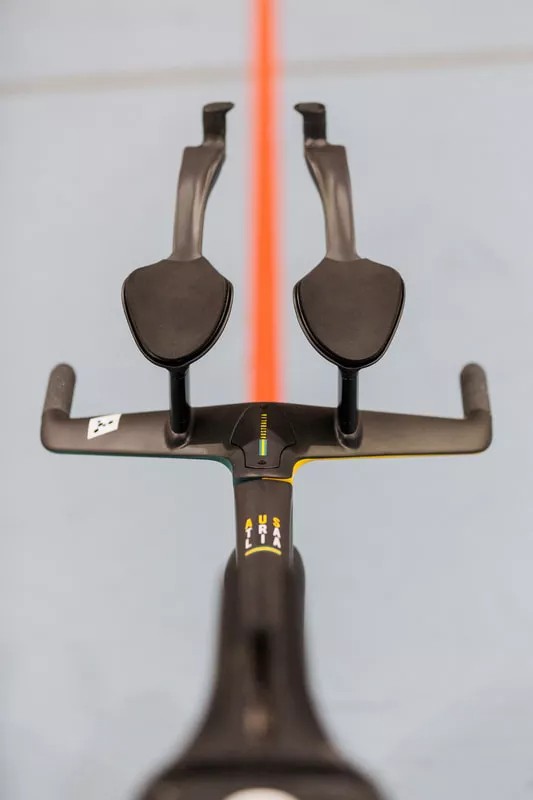
The bikes feature reduced drag and increased stiffness, while extensive work was done developing a narrow fork to apparently reduce drag by up to 30 per cent compared to the previous generation.
They have also been designed to stand a maximum resistance of 350 kilogram-force, which is three times the recommended load, to ensure these machines can withstand the enormous power being put through them by the track athletes.
According to Bikerumor, it will cost about $18,000 for a frameset with frame, fork and Zipp wheels, but we haven’t seen a confirmed price.
France: Look T20

Look unveiled its newest Olympic track weapon at the start of 2020 with a new T20 model ready for the French team to attack the Tokyo games.
The French brand claimed that at "full speed", French athletes could be gaining as much as 30 watts - equating to full bike length over a 200 metre sprint.
The French manufacturer worked closely with Corima to ensure that the wheelsets and axles complement the optimised frame profile.
The brands partnered to design front and rear thru-axle dropouts with the goal of adding torsional rigidity, increasing lateral stiffness by 12.5%, and cutting drag as well as weight.
The newest version was designed and prototyped following years of computational fluid dynamic modelling and wind tunnel testing as well as carbon material research. This version is reportedly 10% lighter than its predecessor, with an 11% reduction in drag and 27% increase in power transfer thanks to an improved stiffness to weight ratio.
Much like the Hope HB.T to be raced by the Great British track team, Look's T20 was created in-house. And, like Lotus, Look has proven heritage on the track, having collected 14 Olympic titles and 43 medals in total.
The Look bike will sport an improved version of the ZED track monobloc crankset first developed for the London 2012 Olympic games, these feature a patented Trilobe concept which allows for the crank arm length to be adjusted.
Sprinters, Madison and scratch riders will use Look's rigid track bar, whilst pursuit athletes will use the Aeroflat bar with Aergo extensions.
With a Corima rear disc and 5-spoke front, the build comes in at 6.8kg - bang on the UCI minimum weight.
The bike is available in two builds - T20 Speed and T20 TT - prices come to £6,999 and £7,499 respectively. It’s one of the ‘cheaper’ Olympic track bikes.
Italy: Pinarello MAAT
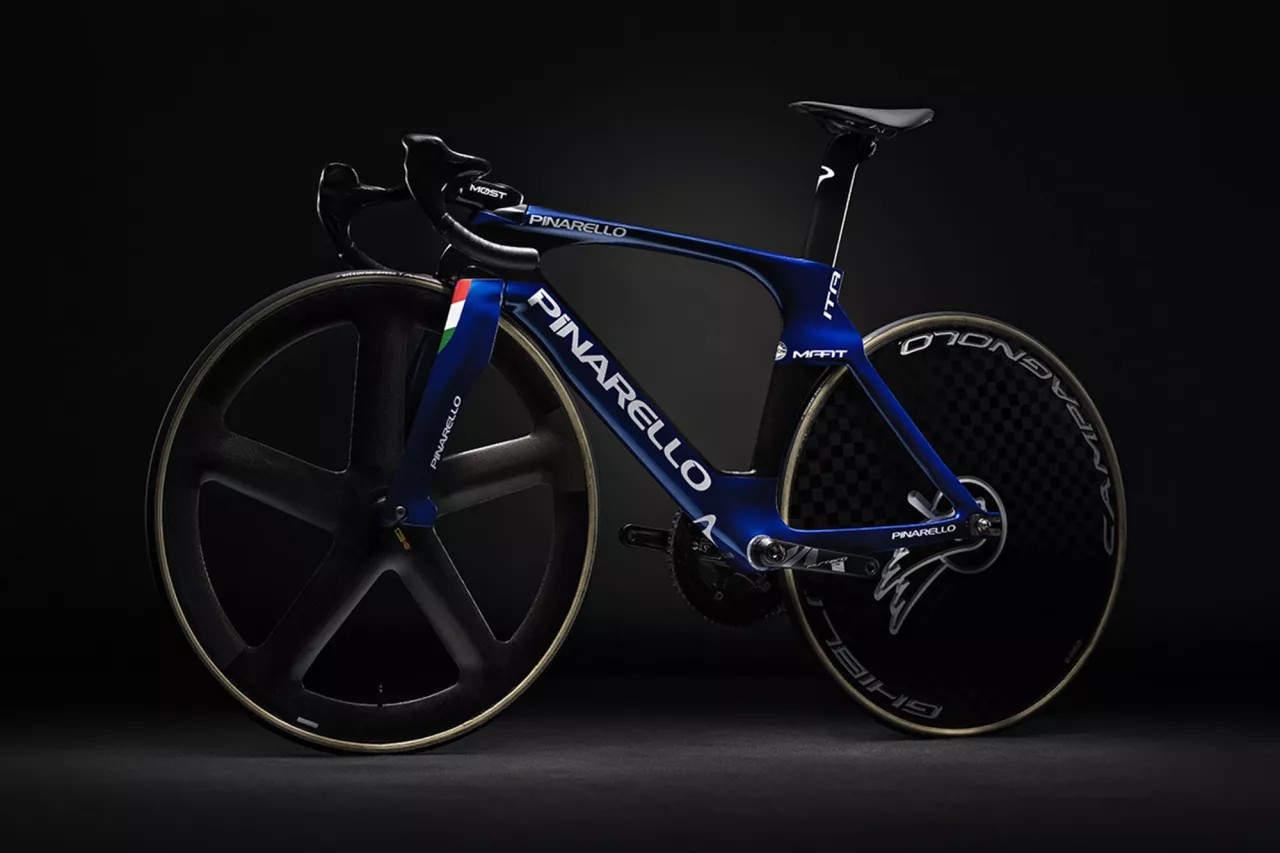
The Italian team will be hoping Pinarello’s MAAT track bike will be the key to success in the Izu velodrome.
Taking over from the Bolide HR that famously helped Sir Bradley Wiggins take the hour record, the MAAT, launched in November 2019, pushes the aerodynamic advantages even further. With the UCI scrapping the archaic 3:1 tubing ratio restrictions, Pinarello was able to redesign the frame of the MAAT to create a highly wind-cheating profile. This sees the head tube, fork and seat stays adopting more elongated and extreme aero shaping to hopefully see success in both sprint and endurance events. The fork in particular has not only the aero shaping but a wide stance designed to improve airflow, not only around the front wheel but also across and around the rider's legs.
Sticking with Pinarello's design ethos on other models the MAAT has the trademark asymmetric design that Pinarello says is to "optimally counteract the asymmetric forces generated during pedalling, to provide symmetrical behaviour when riding the bike”.
This is bolstered by the large, squared off chainstays that look as if they will give zero flex and no loss of power even for the most powerful sprinters.
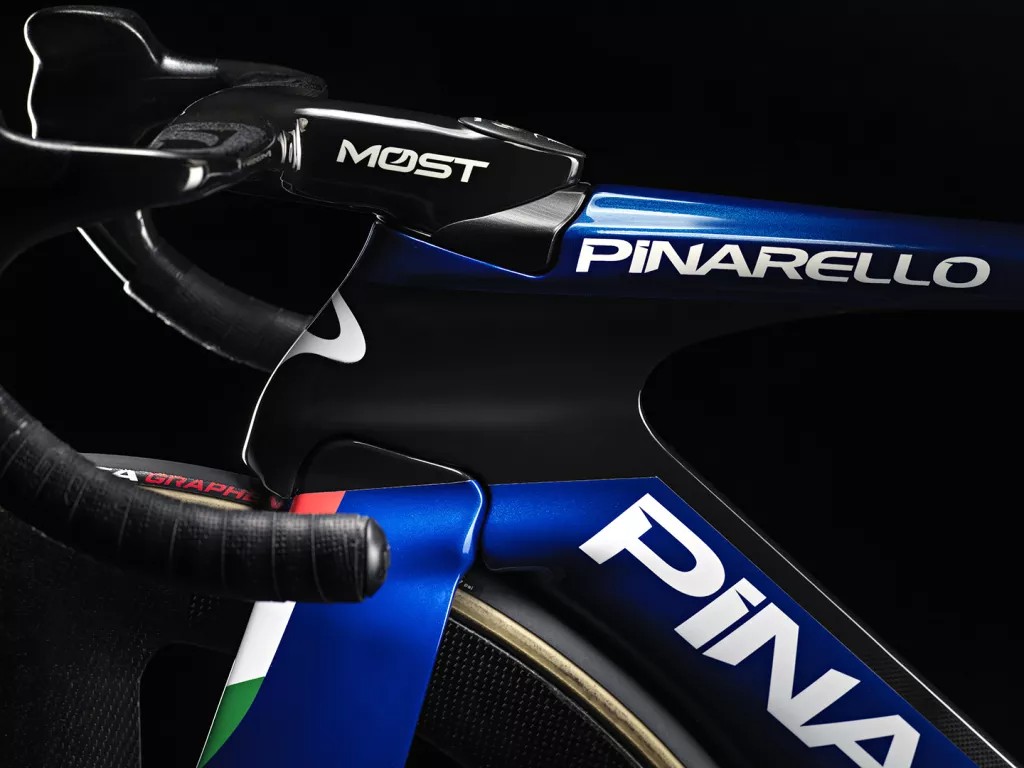
The one-piece carbon cockpit incorporates shaping to mimic shifter hoods allowing racers to adopt the more popular (and aerodynamic) riding position afforded by riding 'in the hoods'. It comes in a single 38cm width with 8.5 degrees of flare. As well as the pseudo-hoods and an aero profile it also features a reducing diameter section near the middle "for better control during Madison hand-slings".
Built from Torayca T1100 1K carbon fibre (the same as Pinarello's latest Dogma F) Pinarello claims a bare frame weight, unpainted for an unspecified size, of 1,350 grams. As with any bike to be used at the Olympics, to comply with rulings and eligibility, it will be on sale to the general public.
You can order the MAAT frameset with three different colour options from your local Pinarello dealer. The new MAAT frame and fork will set you back £7,000, with the integrated handlebar adding a further £750.
Malaysia: Worx WX-R Vorteq
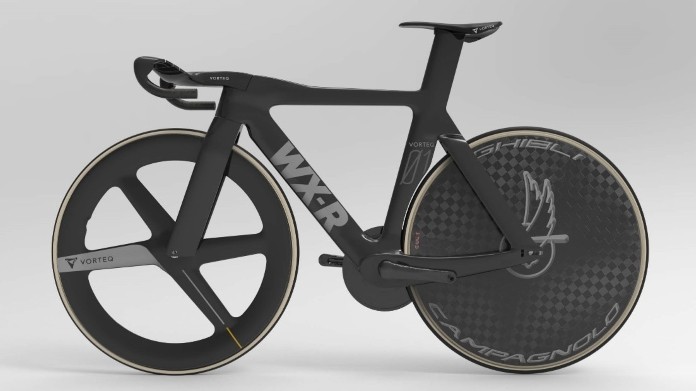
First of all, Malaysia’s bike, designed and made by British brands Vorteq and Worx, is the most expensive of the Tokyo Olympics crop, with the frame coming in at £25,000.
It uses a proprietary four-spoke front wheel that costs another £6,000.
Compared to the Hope x Lotus bike it doesn’t look particularly radical, but it has a very narrow front end and therefore a reduced frontal area: the front wheel uses a thru-axle that’s just 32mm, 7cm narrower than a regular front.
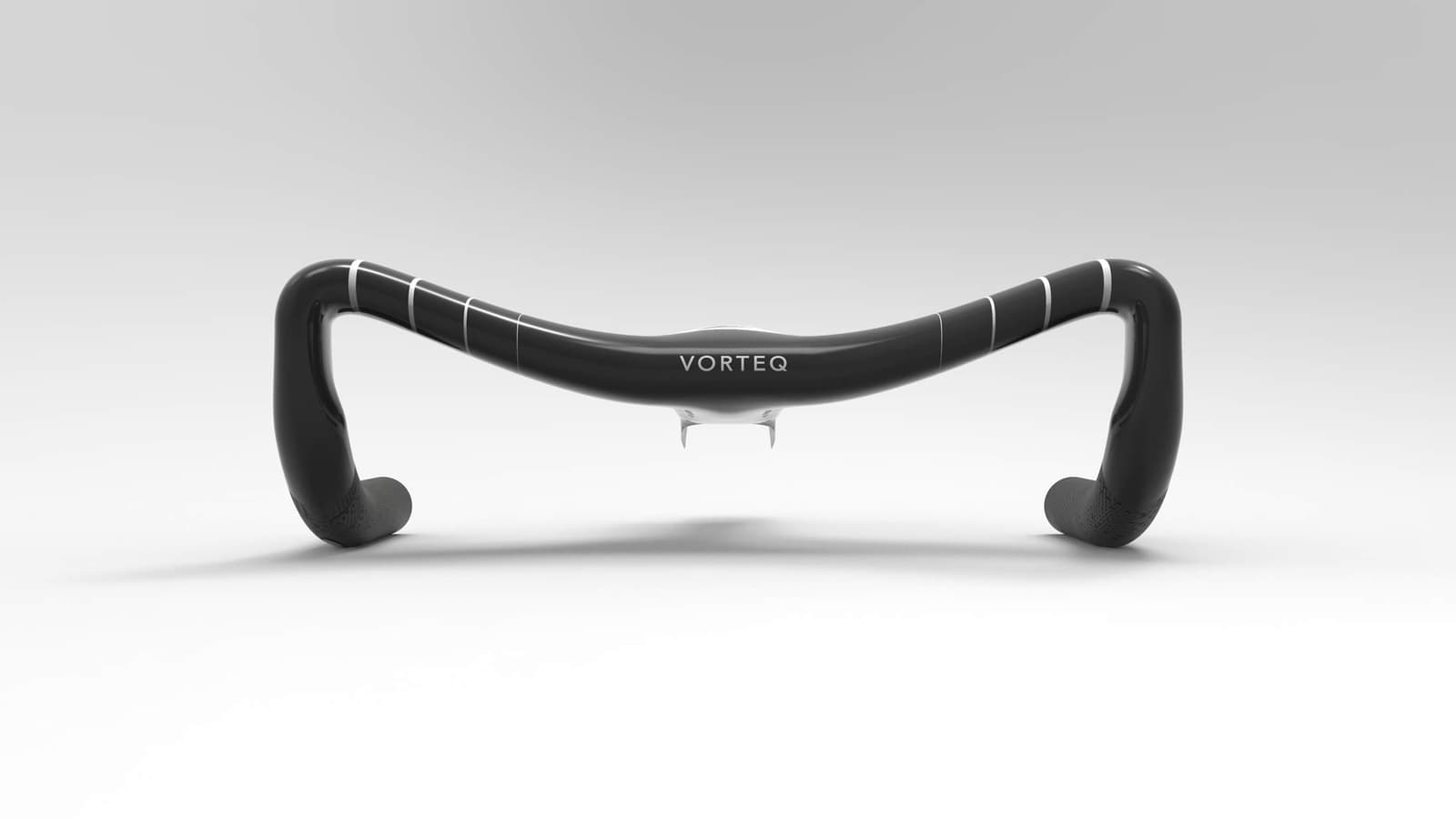
The handlebar, also designed specifically for the bike by Vorteq, is just 30cm wide and costs £10,000.
At the rear the seatstays look to arch over the rear wheel like the Lotus but not in quite such a pronounced way.
Why so expensive? Apparently, it uses cutting edge technology that comes straight from F1.
According to Vorteq, which is based at the Silverstone Sports Engineering Hub, with “many years of CFD expertise gained via working with Formula 1 and motorsports, solving the toughest engineering challenges and delivering supercharged solutions for their clients, the design engineers at Vorteq turned their sights on the goal of creating the world’s fastest track bike.”
The first phase of the project required digitally capturing a series of competitor bikes in high-resolution 3D. Following the scanning, the 3D models of the bikes would be used for cutting-edge CFD analysis combined with the latest wind tunnel testing and research, including analysing the kinesiological riding habits of the rider themselves, and after this, to bring together everything for creating the “ultimate aero track bike,” the Vorteq WX-R.
The team used a handheld 3D scanner, the Artec Leo, designed for capturing medium-sized objects in "breathtaking color." The Artec Leo can entirely capture a race bike in under one minute.
There hasn’t been a huge amount of information released about the bike, but we do know that it's only available in a small and a medium.
Germany: FES B20
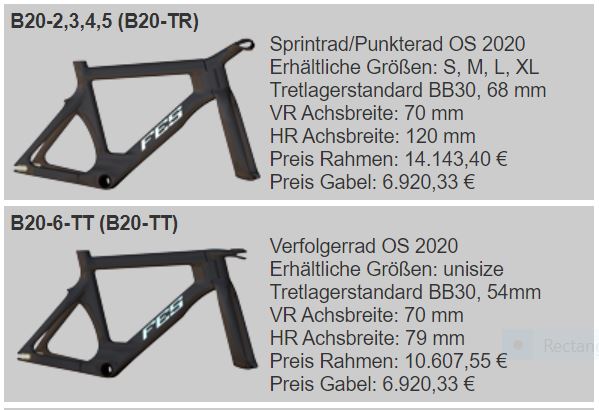
The German team has been using FES bikes supplied by its national institute for developing sports equipment (Institut für Forschung und Entwicklung von Sportgeräten) for as long as anyone can remember - actually since the beginning of the 1980s.
Jens Lehmann was riding an FES in 1992 when he was caught by Chris Boardman in the individual pursuit.
The FES B20 is the latest model that’s headed for Tokyo and comes in sprint and pursuit versions.
The pursuit bike uses narrow axle widths at front and rear - and therefore proprietary wheels - with the front measuring 70mm and the rear a very narrow 79mm. It also uses a narrow bottom bracket at 54mm instead of the standard 68mm.
The sprint bike uses the narrow front axle too, but at the rear has the more conventional track spacing of 120mm and a 68mm BB shell.
FES was always famously secretive and before the UCI required Olympic equipment to be available to the public no other federation could get their hands on one. This is possibly why there’s so little technical information about the frames - and no publicity photos. You want to know more? Then buy one and find out for yourself.
This new design, updating the Rio B16 version, looks sleeker with a more horizontal top tube and the nude carbon is really stunning - that's in high res and in pictures by Tour Magazin that we can't use.
Both FES B20 bikes are for sale on FES’s website (€14,143,40 for the sprint frame and €10,607,55 for the pursuit frame). The wheels are over €4,000 each.
USA: Felt TK-FRD
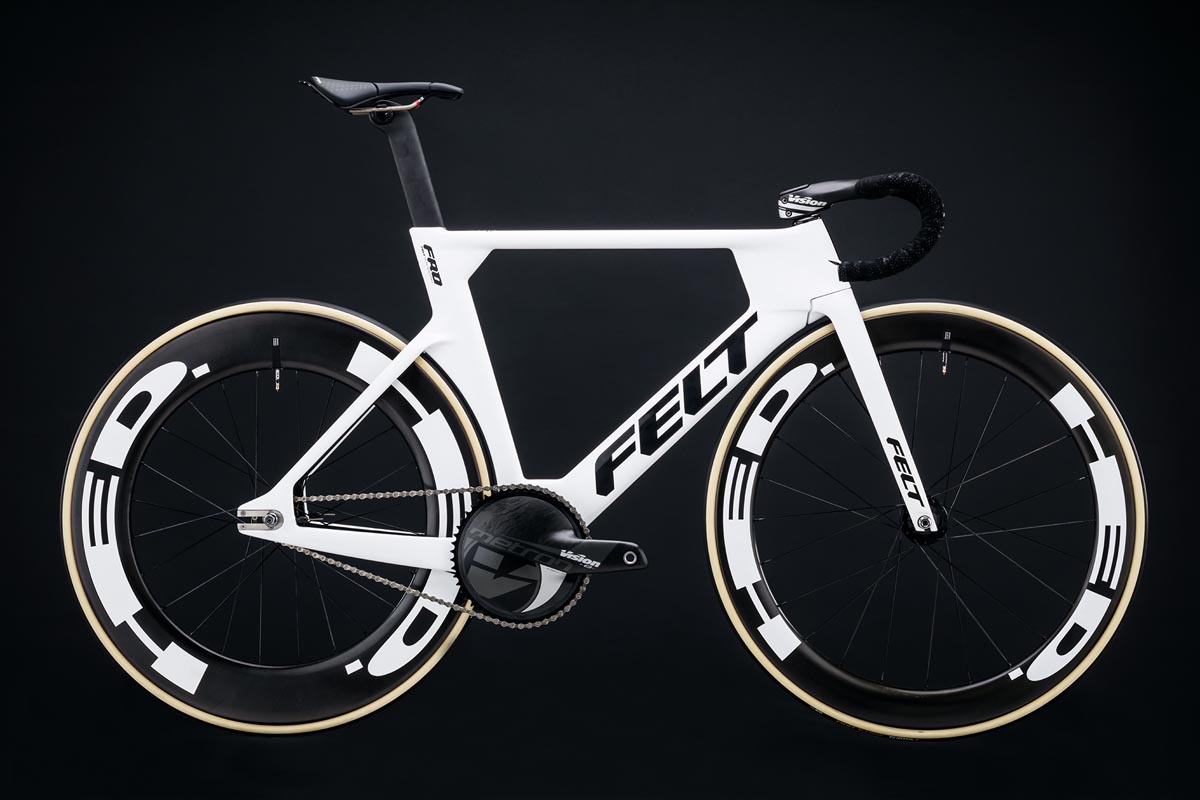
The Felt TK FRD is Team USA’s new track bike for bunch racing and sprints and it’s looking likely that for the pursuit the team will once again use the famous left-hand-drivetrain Felt TA FRD of the Rio Olympics: ‘TK’ just means ‘track’ whereas ‘TA’ stands for ‘track aero’.
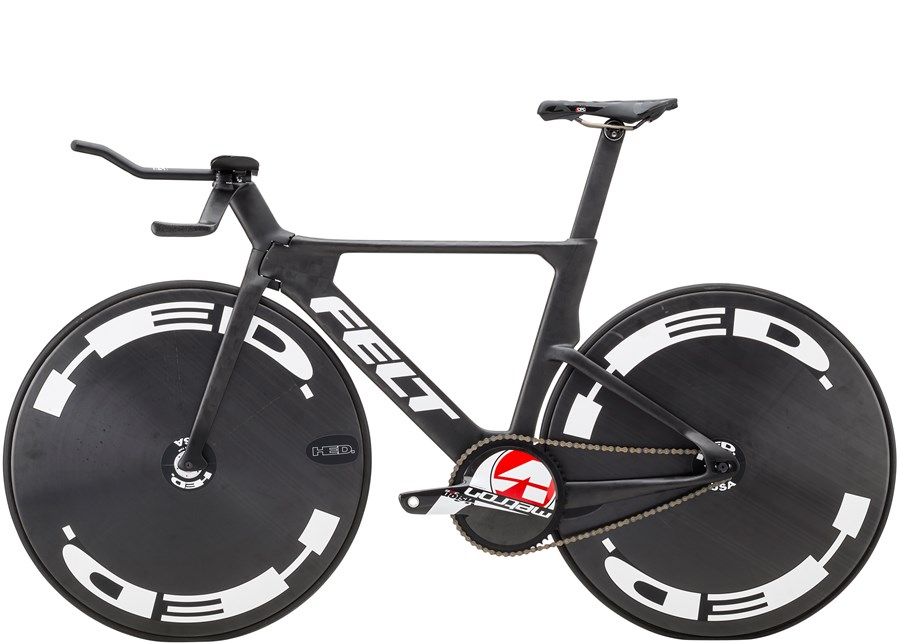
According to Felt: "We found that bikes test faster when the airflow is from the drive side of the bicycle. So by moving the drive side on the bike from the outside of the track, or right-hand side of the bike, to the inner part of the track, or left-hand side of the bike, the bike becomes more aerodynamic, and also handles better because the bike’s weight and center of gravity has moved inboard of the turns.”
Felt says on its website of the new TK FRD: “Ideally suited for mass start events, but also lacking for nothing when it comes to timed events, the TK FRD joins the ranks of the revolutionary TA FRD as being among the very best track bikes the world has ever seen.”
Additionally: “The latest rendition of the TK was painstakingly crafted with the feedback from several world-class track riders and world champions. Its carbon fiber layup is our most advanced ever for a bike intended to be used in mass start events and sprint competitions.”
We do know that the new bike uses standard spacing - 100mm at the front and 120mm at the back compared to the 70mm and 95mm of the left-drivetrain bike - and with other pursuit bikes using narrow axles the TK bike would surely be at a disadvantage. So in all probability, we’ll see the TA from Rio being used again in the team pursuit and the TK for everything else.
The TK FRD frameset retails at $5,499 so it’s quite a bit cheaper than the $26,000 TA FRD, though that's for the complete bike.
Netherlands: Koga Kinsei
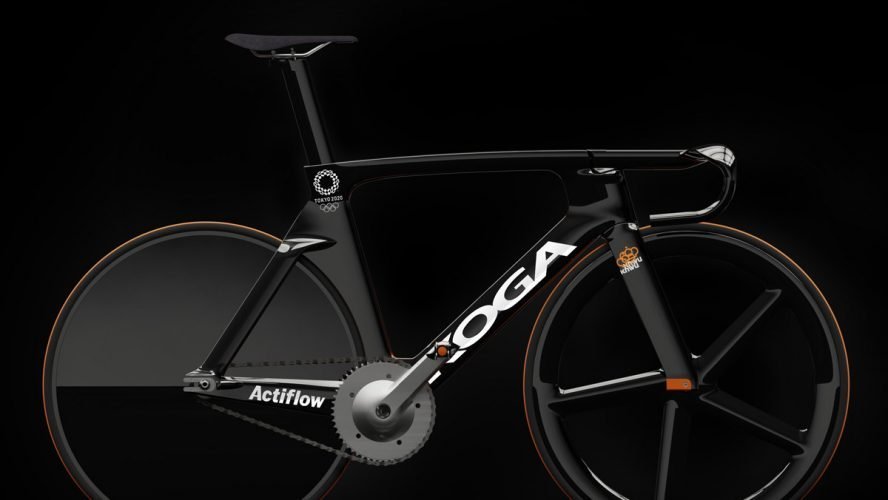
According to Koga, the Tokyo project began 2017, giving enough space for thorough research, development and test time. For the initial drafts and design ideas Koga started with some simulations on the pre existing Koga track bike, developed a while back, and a 3D scan of Jeffrey Hoogland and says it basically started from scratch.
CFD experts Actiflow were responsible for the shape development, partnering with Pontis Engineering for composites, FEM and layup optimisation, and with Delft University for cycling dynamics and wind tunnel measurements. A pre-selection of the Olympic team was at the table during the design and development process.
Koga says the Kinsei frame is focused on the individual sprint and team sprint and says it was able to achieve quite a large gain in performance: “In the wind tunnel we have seen a performance gain more than we estimated at the beginning of the project, fingers crossed!”
There’s no mention of a new pursuit bike - possibly because the Dutch team failed to qualify in Rio after Joost van der Burg crashed.
The Koga Kinsei is widely available to buy for £9,999 (frameset, including fork, seatpost and headset but not bars).
That's our guide to the real showstopper bikes developed by the nations with the biggest cycling budgets, but there are some very tasty-looking ones out there not featured here (yet) that we'll be looking forward to seeing in action in Tokyo.
For example have a look at New Zealand's Avanti Pista (especially with the 3D titanium printed bars), Hong Kong's Pardus CT2020 and not forgetting the home nation's Bridgestone Anchor bikes which have some impressively swoopy carbon bars.
We'll be updating this guide closer to the time, but in the meantime check the schedule for what's happening in Tokyo and when.

Thank you for reading 20 articles this month* Join now for unlimited access
Enjoy your first month for just £1 / $1 / €1
*Read 5 free articles per month without a subscription

Join now for unlimited access
Try first month for just £1 / $1 / €1
Simon Smythe is a hugely experienced cycling tech writer, who has been writing for Cycling Weekly since 2003. Until recently he was our senior tech writer. In his cycling career Simon has mostly focused on time trialling with a national medal, a few open wins and his club's 30-mile record in his palmares. These days he spends most of his time testing road bikes, or on a tandem doing the school run with his younger son.
-
 A bike rack with an app? Wahoo’s latest, and a hub silencer – Sea Otter Classic tech highlights, Part 2
A bike rack with an app? Wahoo’s latest, and a hub silencer – Sea Otter Classic tech highlights, Part 2A few standout pieces of gear from North America's biggest bike gathering
By Anne-Marije Rook Published
-
 Cycling's riders need more protection from mindless 'fans' at races to avoid another Mathieu van der Poel Paris-Roubaix bottle incident
Cycling's riders need more protection from mindless 'fans' at races to avoid another Mathieu van der Poel Paris-Roubaix bottle incidentCycling's authorities must do everything within their power to prevent spectators from assaulting riders
By Tom Thewlis Published